Highland Games
Find a Highland Games near you!
BRIEF OVERVIEW OF HIGHLAND GAMES
The following game descriptions are provided by the St. Louis Scottish Games and Cultural Festival.
Origins of the Events
There are many legends about the origins of the Scottish Games. The oldest traces the Games tradition back to the period of Roman invasions in the 2nd and 3rd centuries, where Scottish warriors reputedly displayed their bravery and strength by performing feats of skill and power in front of the opposing army.
The most widely accepted tale describes the Games as informal athletic tests by which Kings and Clan Chiefs examined the agility, cunning and physical strength of their clansmen. The victors of these trials were then awarded positions of leadership both on the battlefield and within the clan.
The Scottish Highland Games or “Heavy Events” are the modem continuation of this ancient Celtic tradition. Each event you watch today may look like a simple matter of brute strength, but each also requires excellent timing, balance and technique (they also require a kilt!).
There are seven traditional events: Braemar Stone, Open Stone, Weight for Distance, Hammer, Sheaf, Weight over Bar, and Caber Toss.
Distance Events
Braemar Stone
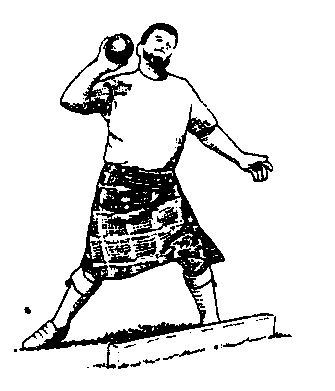 In the Braemar Stone Putt, athletes throw a 22-pound, round stone from a stationary position (no running approach allowed). The competitor cannot touch the top of the trig (toe bar) nor the ground beyond it before or after the throw. Historically, the Braemar Stone Putt stems from a common practice by early Highland Chieftains who kept a large stone outside their gatepost, and challenged the throwing arms of every visiting clan’s warriors.
In the Braemar Stone Putt, athletes throw a 22-pound, round stone from a stationary position (no running approach allowed). The competitor cannot touch the top of the trig (toe bar) nor the ground beyond it before or after the throw. Historically, the Braemar Stone Putt stems from a common practice by early Highland Chieftains who kept a large stone outside their gatepost, and challenged the throwing arms of every visiting clan’s warriors.
Open Stone
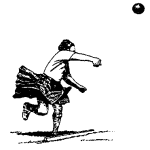 This event will remind the viewer of the Olympic shot putt. Contestants run up a 7’6″ approach path, and using only one hand, throw a 16-pound river stone from behind a trig (toe bar). Historical records suggest that this skill came in handy for men under siege: the successful stone putter would be posted on the battlements, where he could hurl boulders down onto the attackers.
This event will remind the viewer of the Olympic shot putt. Contestants run up a 7’6″ approach path, and using only one hand, throw a 16-pound river stone from behind a trig (toe bar). Historical records suggest that this skill came in handy for men under siege: the successful stone putter would be posted on the battlements, where he could hurl boulders down onto the attackers.
Weight for Distance (56-pound and 28-pound)
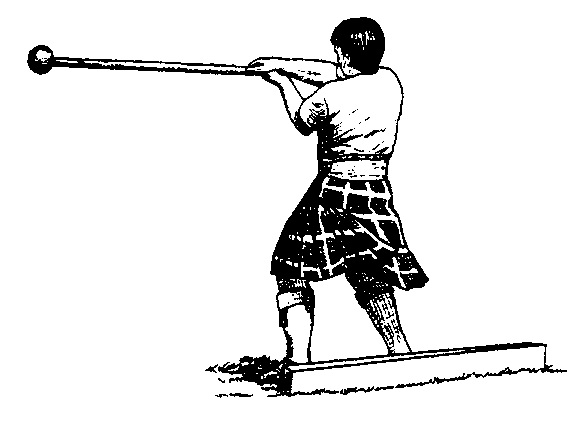 The weights used for distance throwing are common box weights, attached to a ring handle by chain; the overall length is 18 inches. Contestants are allowed a nine-foot run up, but must use only one hand to throw, and have to remain behind the trig (toe bar) during and after the throw. The athlete spins before releasing the weight (similar to a discus-thrower), and is scored on the distance it flies. Each competitor is given three tries with each weight, and is scored on the best of the three.
The weights used for distance throwing are common box weights, attached to a ring handle by chain; the overall length is 18 inches. Contestants are allowed a nine-foot run up, but must use only one hand to throw, and have to remain behind the trig (toe bar) during and after the throw. The athlete spins before releasing the weight (similar to a discus-thrower), and is scored on the distance it flies. Each competitor is given three tries with each weight, and is scored on the best of the three.
Hammer
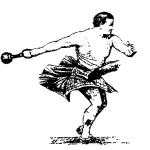 The original hammer used in Scotland was that used by the men working in the granite quarries. In America, it was the heavy, long- handled blacksmith’s hammer. Today’s Scottish hammer features an iron ball fitted on a long, flexible shaft. The hammer has an overall length of 50 inches, and comes in two weights: “Light” (16 lb.) and “Heavy” (22 lb.) For the throw, the shaft is gripped by the athlete and swung around in two or three complete turns, then hurled through the air. Three throws are allowed, but only the longest throw is scored.
The original hammer used in Scotland was that used by the men working in the granite quarries. In America, it was the heavy, long- handled blacksmith’s hammer. Today’s Scottish hammer features an iron ball fitted on a long, flexible shaft. The hammer has an overall length of 50 inches, and comes in two weights: “Light” (16 lb.) and “Heavy” (22 lb.) For the throw, the shaft is gripped by the athlete and swung around in two or three complete turns, then hurled through the air. Three throws are allowed, but only the longest throw is scored.
Height Events
Sheaf Toss
The sheaf toss has roots on the farms of Scotland. Using pitchforks, young men would attempt to pitch wheat to the storage loft on the barn’s second floor. In competition, a sheaf (burlap bag filled with hay) weighing 20 pounds is thrown over a crossbar with a pitchfork. Contestants are allowed three attempts to clear the bar at each height.
56-pound weight over bar
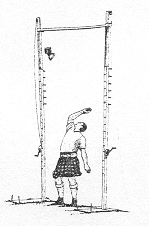 The object here is to toss a 56-pound weight up and over a high crossbar using only one hand. The event is believed to have begun as a training method for tossing the grappling hooks used for scaling tall fortifications. An athlete is not required to compete until the bar is at a height where he or she wishes to enter the competition. Once the athlete starts to throw, he or she must compete each time the bar is raised. Each competitor gets three tosses at each height.
The object here is to toss a 56-pound weight up and over a high crossbar using only one hand. The event is believed to have begun as a training method for tossing the grappling hooks used for scaling tall fortifications. An athlete is not required to compete until the bar is at a height where he or she wishes to enter the competition. Once the athlete starts to throw, he or she must compete each time the bar is raised. Each competitor gets three tosses at each height.
Caber Toss
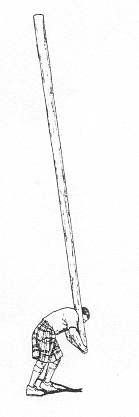 The tossing of a caber (a felled tree) is probably the most famous of the Scottish events. It dates from the 16th Century where it may have begun as a military tactic used to breach barriers or bridge rivers.
The tossing of a caber (a felled tree) is probably the most famous of the Scottish events. It dates from the 16th Century where it may have begun as a military tactic used to breach barriers or bridge rivers.
In the caber toss, the athlete attempts to flip a section of tree, – averaging 18 feet and weighing 80 to 120 pounds ? end-over-end by holding it upright against the shoulder, running a short distance, and thrusting it up and over. The goal is to make the narrow end (the one the athlete holds) flip over the wider end.
In a perfect turn, the wide end of the caber crashes to the ground, and the pole falls directly away from the athlete in a “twelve o’clock” position. Points are deducted according to the number of degrees the lay of the caber varies from the perfect, 12 o’clock mark. All athletes are allowed three tosses, and all successful attempts are scored to determine the Winner.